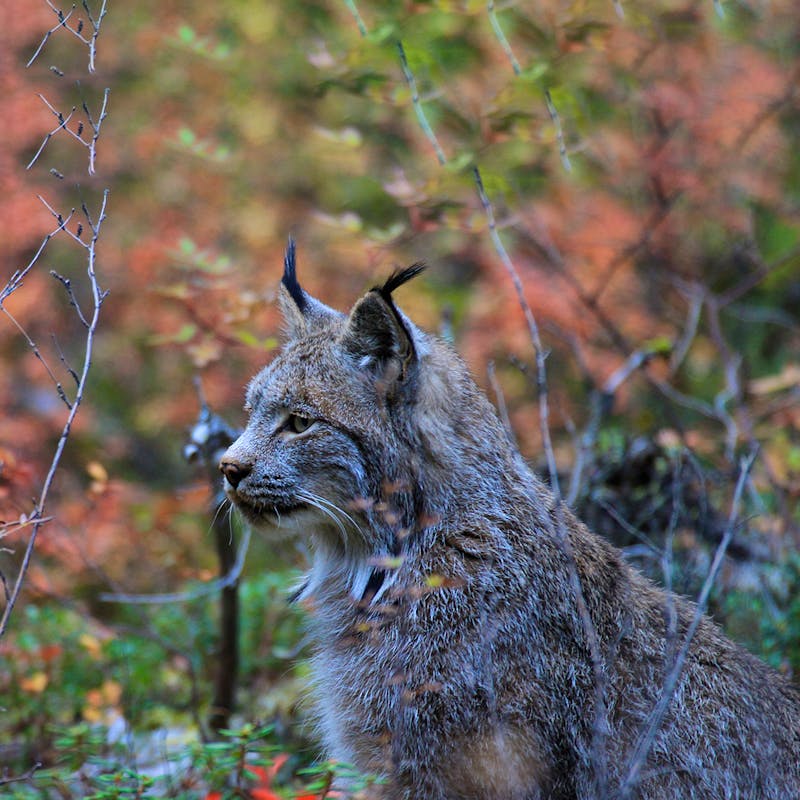Meet one of North America's most elusive and enchanting wild cats, the Canada Lynx. Montana’s remote forests and rugged terrain offer an ideal habitat for this iconic cat, which sports tufted ears, long legs and oversized feet. Yet it faces a precarious existence.
Read on to learn more about the challenges and success of lynx conservation efforts in Montana, and the ongoing strategies to help ensure the survival of this species.
Meet the Canada Lynx
Canada lynx (Lynx canadensis) are medium-sized cats that are approximately two feet tall and weigh up to 31 pounds. They are adapted to cold climates and are primarily found in the boreal forests of Canada and in the mountainous regions of the United States. In Montana, the lynx's range spans the Lolo and Flathead National Forests and adjacent forested areas where they find both the dense cover and prey needed to survive.
These wildcats thrive in areas with deep snow, which provides an advantage in hunting their primary prey: the snowshoe hare. The lynx’s impressive adaptations, including large paws that act as snowshoes, make it a specialist predator in its habitat.
Four Threats
Canada lynx face several threats that jeopardize their survival in Montana and, in some cases, throughout their range. Here are the big four:
1. Habitat Loss and Fragmentation: As human activities such as logging, road construction and land development expand, lynx habitats become fragmented. This fragmentation limits the lynx's access to critical resources and can isolate populations, making it difficult for individuals to find mates and disperse.
2. Climate Change: Warming temperatures can lead to reduced snow cover, which affects the lynx’s ability to hunt snowshoe hares. Additionally, changes in forest composition due to shifting climate patterns can alter the lynx’s habitat and prey availability.
3. Competition and Predation: Climate change doesn’t just impact the lynx’s ability to hunt, it also increases competition with other native predators, such as coyotes and bobcats. As warm temperatures reduce snow cover, other predators can outcompete lynx during winter, when this species normally reigns supreme.
4. Trapping and Enforcement of Legal Protections: Canada lynx are legally protected under the Endangered Species Act, but sustained enforcement of regulations and habitat management are critical to protect this species. For example, trapping lynx is largely banned, both in the U.S. and Canada. Illegal trapping and bycatch in traps set for other species, however, is problematic. Trapping regulations applied to other species often have negative impacts in lynx due to incidental capture. As we see trapping regulations loosened for species like wolves, there is a strong chance there will be an increase in lynx mortality as well.
Saving Canada Lynx
Efforts to conserve the Canada lynx in Montana are multifaceted. They involve federal, state and local agencies, as well as non-governmental organizations like Defenders of Wildlife. These efforts include habitat protection, research and public outreach.
Protecting and restoring lynx habitat is crucial. We need to ensure logging and other activities do not negatively impact lynx habitat. The creation of designated lynx habitat helps maintain habitat corridors and minimize human disturbances. Proactive habitat management and conservation planning also helps us understand and address the impacts of climate change. Strategies include maintaining and restoring connectivity between lynx habitats to allow for natural dispersal and adjusting forest management practices to support healthy ecosystems that can better withstand climate change.
Ongoing research continues to provide valuable insights into lynx populations and their needs. Studies tracking lynx movements, population dynamics and habitat use through methods like GPS collaring and remote camera surveys continue to inform management decisions and conservation measures.
Collaboration, Success and Ongoing Challenges
Canada lynx conservation efforts in Montana have seen some successes. Collaborative efforts between agencies and conservationists have led to better habitat management practices and increased public support for lynx conservation. Challenges remain, however, and ongoing efforts are crucial to continued restoration of this species.
Monitoring, adaptive management and public engagement are essential to address emerging threats and ensure long-term survival of this wild cat. Conservation is a dynamic process requiring flexibility and perseverance to navigate the evolving landscape of ecological and human pressures.
The Canada lynx is more than just a beautiful and elusive predator. It is a vital part of Montana’s forest ecosystems. By understanding the challenges this wild cat faces and supporting targeted conservation efforts, we can help ensure Canada lynx remain a thriving part of Montana’s wilderness for generations to come.










